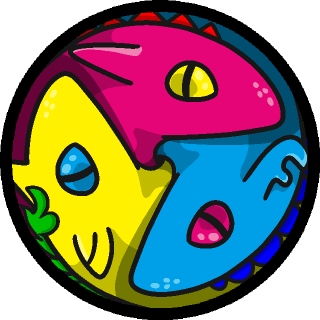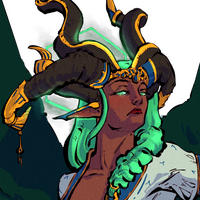Amphiptere (am-hip-teer; amf-hip-teer)
"Shoot all the wyverns you want, if you can hit'em, but remember it is a sin to hurt an amphiptere."
A strange combination of snake, bird, and mammal, amphipteres are found only on the Saredian Islands of Auzera's east coast. Peaceful herbivores, amphipteres spend their time gliding from island to island, feasting on fruit, and sunbathing. Their beautiful feathers are admired and highly sought-after, especially the extra long tail feathers of males.
Harming an amphiptere is a grievous crime. They are symbolic of innocence, joy, and good luck. They have no natural predators and are easygoing and curious.
Amphipteres are specifically adapted to the floating islands, and could not survive anywhere else. Increased tourism near the islands has threatened their habitat.
Basic Information
Anatomy
Amphipteres aren't quite birds, but aren't quite mammals, either. They have the beak, feathers, and wings of a bird, but the skeletal structure, horns, ears, and eyes of a mammal. They have no extant relatives, and are the last of their genus.
Their most notable feature is their huge, clawed wings, which are their only limbs. The rest of their body is snake-like. Their tail ends with a fan of feathers. They move with a combination of slithering and crawling, using their arms to pull them forward as their tail pushes against the ground. Their belly lacks feathers, exposing thick, leathery skin.
To move quickly, they have to fly. Their wings are designed for gliding and soaring with minimal flapping. They cannot take off straight from the ground, and instead must jump off the edge of a floating island to take flight.
They have side-facing eyes with round pupils, enabling almost 360-degree vision. Their beak is large and blunt, perfect for plucking their main food-source, uku fruit, from the vine. Short horns protrude from the top of their head, and petal-shaped ears stick out from the sides. They can rotate their ears at many angles.
Sexual Dimorphism
Male and female amphipteres are easily distinguished. Males have vibrant red, blue, and yellow plumage. Females are bigger than males and have cyan and yellow feathers. Males have an extra set of horns in front of the first set, and a pair of long, ribbon-like feathers extending from the end of their tail.

Reproduction
Amphipteres reproduce sexually and mate at the end of the rainy season. Males use their flashy plumage to perform ritual "dances" to attract females. They compete with other males by brandishing their extra set of horns and puffing out their feathers to look big and intimidating.
While their claws, beak, and horns could be dangerous, males almost never actually use them in combat. Instead, they prefer to bluster and boast until their opponent gives up. This display can take hours, and sometimes the females they're competing for lose interest before it ends.
Pairs mate for life, and remain social with one another even after mating season has passed. They will build a grounded nest out of foliage in a secluded part of a floating island. Females lay a clutch of two to three eggs. The duty of protecting the eggs is shared between both partners. Eggs are about six inches long, mottled brown in color, and will hatch within two months.
Growth Rate & Stages
Baby amphipteres remain in the nest until they are big enough to fly, which takes between six and eight months. During this time, their parents work hard to protect them and provide them with food. Both the male and female take turns guarding and foraging. They bring the babies nuts and fruits that they crush with their large beaks to make them small enough for the babies to eat.
When the babies are ready, they will throw themselves off of their home island and take flight for the first time. Juveniles remain near their parents for the next few months of their life. Over time, their parents will care for them less and less, until the juvenile either learns to or is forced to live on its own.
Adult amphipteres keep bonds of familiarity with their parents and siblings. They sometimes can be seen socializing and grooming each other many years after their hatching.
Symbolism
The amphiptere's association with the Saredian Islands make them icons of the region's most notable themes. Peace, luck, prosperity, innocence, and joy are all associated with both Saredia and the amphipteres.
They are the mascot of paradise. Hurting one would be harming an innocent, harmless creature with virtually no means to defend itself. It's an unforgivable crime, and is said to bring a dark curse over the murderer and their bloodline. The only situation in which killing an amphiptere is okay is if it is stranded and already dying. In this context, ending their suffering is expected. It should be done with great reverence and sorrow.
Because amphipteres should not be harmed, their beautiful feathers are rare and treasured gifts. Coming across one is a sign of monumental good fortune. The long tail feathers of males are extra rare and extra special. They are sometimes turned into pens, which are worth a small fortune. Feathers are also used in jewelry or talismans that are said to bring good luck if worn.
The symbol of the amphiptere is used in the crests and flags of many organizations near the Saredian Isles. Artistic depictions of them symbolize peace. Depictions of them being harmed are often used as political commentary, to accuse the perpetrator as evil or war-mongering.

Ecology & Habitat
Amphipteres rely on their floating island habitats for everything. They nest on the islands, feed on the fruits that grow on them, and jump off of them in order to fly. Without the islands, Amphipteres would be stranded on the ground with no way to survive.
Their powerful claws allow them to grip the sides of the islands as they forage for the uku fruit growing on the edges. Their long, flexible neck allows them to reach lots of fruit without having to reposition often.
Strict Islanders
If an amphiptere ends up on the ground, it is done for. With no way to fly without a ledge to jump off of, they cannot return to the islands. Most stranded amphipteres are sick, injured, or very old. They quickly perish from starvation or land-based predators.
Amphiptere Idioms
Idioms referencing amphipteres are used across Eastern Auzera, not just near Saredia.
"A grounded amphiptere."
"To kill an amphiptere/killing the amphiptere."
"An amphiptere's feather" or "a red feather."
"[To be like] an amphiptere."








'sometimes the females they're competing for lose interest before it ends.' Mood. I love them. Must protect. (You have a FRUIT* in the sidebar that I think you missed during editing.)
Explore Etrea | March of 31 Tales
I knew I'd miss one! Thank you so much for the kind words and for pointing it out <3